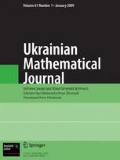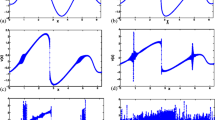Abstract
We propose an approach to the analysis of turbulent oscillations described by nonlinear boundary-value problems for partial differential equations. This approach is based on passing to a dynamical system of shifts along solutions and uses the notion of ideal turbulence (a mathematical phenomenon in which an attractor of an infinite-dimensional dynamical system is contained not in the phase space of the system but in a wider functional space and there are fractal or random functions among the attractor “points”). A scenario for ideal turbulence in systems with regular dynamics on an attractor is described; in this case, the space-time chaotization of a system (in particular, intermixing, self-stochasticity, and the cascade process of formation of structures) is due to the very complicated internal organization of attractor “points” (elements of a certain wider functional space). Such a scenario is realized in some idealized models of distributed systems of electrodynamics, acoustics, and radiophysics.
Similar content being viewed by others
References
A. Avila, M. Lyubich, and W. de Melo, “Regular or stochastic dynamics in real analytic families of unimodal maps,” Invent. Math., 154, 451–550 (2003).
A. V. Babin and M. I. Vishik, Attractors of Evolutionary Equations [in Russian], Nauka, Moscow (1989).
M. Born, “Vorhersagbarkeit in der klassichen Mechanik,” Z. Phys., 153, 372–388 (1958).
A. A. Vitt, “On the theory of a violin string,” Zh. Tekhn. Fiz., 6, No. 9, 1459–1479 (1936).
K. L. Cooke and D. Krumme, “Differential difference equations and nonlinear initial-boundary-value problems for linear hyperbolic differential equations,” J. Math. Anal. Appl., 24, 372–387 (1968).
N. S. Krylov, Works on the Substantiation of Statistical Physics [in Russian], Academy of Sciences of the USSR, Moscow-Leningrad (1950).
O. A. Ladyzhenskaya, “On the determination of a global attractor for the Navier-Stokes equation and other partial differential equations,” Usp. Mat. Nauk, 42, No. 6, 25–60 (1987).
K. A. Lukin, Yu. L. Maistrenko, A. N. Sharkovsky, and V. P. Shestopalov, “Nonlinear difference equations with two argument deviations in the electro-dynamics problems,” in: Proceedings of the IVth International Workshop “Plasma Theory and Nonlinear and Turbulent Processes in Physics” [in Russian], Naukova Dumka, Kiev (1989).
K. A. Lukin, Yu. L. Maistrenko, A. N. Sharkovskii, and V. P. Shestopalov, “Method of difference equations in the resonance problem with nonlinear reflection,” Dokl. Akad. Nauk SSSR, 309, No. 2, 327–331 (1989).
M. Lyubich, “Almost any real quadratic map is either regular or stochastic,” Ann. Math., 156, 1–78 (2002).
Yu. L. Maistrenko, V. L. Maistrenko, S. I. Vikul, and L. O. Chua, “Bifurcations of attracting cycles from time-delayed Chua’s circuit,” Int. J. Bifurcation Chaos, 5, No. 3, 653–671 (1995).
Yu. L. Maistrenko, E. Yu. Romanenko, and A. N. Sharkovsky, “Attractors of difference equations and turbulence,” in: Proceedings of the IIIrd International Workshop “Plasma Theory and Nonlinear and Turbulent Processes in Physics,” World Scientific, Singapore (1988), pp. 520–536.
J. Milnor, “On the concept of attractor,” Commun. Math. Phys., 99, 177–195 (1985).
J. Nagumo and M. Shimura, “Self-oscillation in a transmission line with a tunnel diode,” Proc. IEEE, 49, 1281–1291 (1961).
H. O. Peitgen, H. Jürgens, and D. Saupe, Chaos and Fractals: New Frontiers of Science, Springer, New York (1993).
E. Yu. Romanenko, “On attractors of continuous time difference equations,” Comput. Math. Appl., 36, No. 10–12, 377–390 (1998).
E. Yu. Romanenko, “Dynamical systems induced by continuous time difference equations and long-time behavior of solutions,” Int. J. Difference Equat. Appl., 9, No. 3–4, 263–280 (2003).
O. Yu. Romanenko, “Dynamical systems generated by difference equations with continuous time,” in: Proceedings of the Ukrainian Mathematical Congress, Dynamical Systems [in Ukrainian], Institute of Mathematics, Ukrainian National Academy of Sciences, Kyiv (2003), pp. 93–104.
E. Yu. Romanenko, “Dynamics of neighborhoods of points in the case of continuous mapping of an interval,” Ukr. Mat. Zh., 57, No. 11, 534–547 (2005).
O. Yu. Romanenko, “Phenomenon of self-stochasticity in dynamical systems generated by difference equations with continuous argument,” Ukr. Mat. Zh., 58, No. 7, 954–975 (2006).
E. Yu. Romanenko and A. N. Sharkovsky, “Formation of structures and autostochasticity in distributive systems,” in: Proceedings of the IVth International Workshop “Nonlinear and Turbulent Processes in Physics,” Vol. 2, Naukova Dumka, Kiev (1989), pp. 416–419.
O. Yu. Romanenko and O. M. Sharkovs’kyi, “From one-dimensional to infinite-dimensional dynamical systems: ideal turbulence,” Ukr. Mat. Zh., 48, No. 12, 1604–1627 (1996).
E. Yu. Romanenko and O. N. Sharkovsky, “From boundary value problems to difference equations: A method of investigation of chaotic vibrations,” Int. J. Bifurcation Chaos, 9, No. 7, 1285–1306 (1999).
E. Yu. Romanenko, A. N. Sharkovsky, and M. B. Vereikina, “Self-structuring and self-similarity in boundary value problems,” Int. J. Bifurcation Chaos, 5, No. 5, 145–156 (1999).
E. Yu. Romanenko, A. N. Sharkovsky, and M. B. Vereikina, “Self-stochasticity in deterministic boundary value problems,” Nonlin. Bound. Val. Probl., 9, 174–184 (1999).
V. V. Fedorenko, “Topological limit of trajectories of an interval of the simplest one-dimensional dynamical systems,” Ukr. Mat. Zh., 54, No. 3, 425–430 (2002).
A. N. Sharkovskii, “Oscillations described by autonomous difference and differential-difference equations,” in: Proceedings of the VIIIth International Conference on Nonlinear Oscillations, Vol. 2, Academia, Prague (1979), pp. 1073–1078.
A. N. Sharkovsky, “’Dry’ turbulence,” in: Short Comm. Int. Congr. Math., Vol. 10, Warsaw (12) (1983), p. 4.
A. N. Sharkovsky, “’Dry’ turbulence,” in: Proceedings of the International Workshop “Nonlinear and Turbulent Processes in Physics,” Vol. 3 (1984), pp. 1621–1626.
A. N. Sharkovsky, “Chaos from a time-delayed Chua’s circuit,” IEEE Trans. Circ. Syst., 40, No. 10, 781–783 (1993).
A. N. Sharkovsky, “Ideal turbulence in an idealized time-delayed Chua’s circuit,” Int. J. Bifurcation Chaos, 4, No. 2, 303–309 (1994).
A. N. Sharkovsky, “Universal phenomena in some infinite-dimensional dynamical systems,” Int. J. Bifurcation Chaos, 5, No. 5, 1419–1425 (1995).
A. N. Sharkovsky, “Iteration of continuous functions and dynamics of solutions for some boundary value problems,” Ann. Math. Silesianae (Proceedings of the International Conference on Iteration Theory), 13, 243–255 (1999).
O. M. Sharkovs’kyi, “Dynamical systems generated by boundary-value problems. Ideal turbulence. Computer turbulence,” in: Proceedings of the Ukrainian Mathematical Congress, Dynamical Systems [in Ukrainian], Institute of Mathematics, Ukrainian National Academy of Sciences, Kyiv (2003), pp. 125–129.
A. N. Sharkovsky, “Difference equations and boundary value problems,” in: New Progress in Difference Equations, Proceedings of the International Conference “Differential Equations and Applications” (ICDEA-2001) (2004), pp. 3–22.
A. N. Sharkovsky, “Ideal turbulence: definition,” in: Grazer Math. Berichte, Proceedings of the International Conference on Iteration Theory, No. 346 (2004), pp. 403–412.
A. N. Sharkovsky, “Ideal turbulence,” Nonlin. Dynam., 44, 15–27 (2006).
A. N. Sharkovsky, P. Deregel, and L. O. Chua, “Dry turbulence and period-adding phenomena from a 1-D map,” Int. J. Bifurcation Chaos, 5, No. 5, 1283–1302 (1995).
A. N. Sharkovsky, Yu. L. Maistrenko, P. Deregel, and L. O. Chua, “Dry turbulence from a time delayed Chua’s circuit,” Syst. Comput., 3, No. 2, 645–668 (1993).
A. N. Sharkovsky, Yu. L. Maistrenko, and E. Yu. Romanenko, Difference Equations and Their Applications, Kluwer, Dordrecht (1993).
A. N. Sharkovsky and E. Yu. Romanenko, “Ideal turbulence: attractors of deterministic systems may lie in the space of random fields,” Int. J. Bifurcation Chaos, 2, No. 1, 31–36 (1992).
O. M. Sharkovs’kyi and O. Yu. Romanenko, “Self-stochasticity: attractors of deterministic problems can contain random functions,” Dopov. Nats. Akad. Nauk Ukr., No. 10, 33–39 (1992).
O. M. Sharkovs’kyi and O. Yu. Romanenko, “Asymptotic properties of solutions of one class of boundary-value problems,” Dopov. Nats. Akad. Nauk Ukr., No. 3, 43–48 (1999).
A. N. Sharkovskii and E. Yu. Romanenko, “Difference equations and dynamical systems generated by some classes of boundary-value problems,” Tr. Mat. Inst. Ros. Akad. Nauk, 244, 281–296 (2004).
A. N. Sharkovsky and E. Yu. Romanenko, “Turbulence: ideal,” in: A. Scott (editor), Encyclopedia of Nonlinear Science, Routledge, New York (2005), pp. 955–957.
A. N. Sharkovsky, E. Yu. Romanenko, and S. A. Berezovsky, “Ideal turbulence: definition and models,” in: Proceedings of the International Conference “Physics and Control,” Vol. 1, Petersburg (2003), pp. 23–30.
A. N. Sharkovsky, E. Yu. Romanenko, and V. V. Fedorenko, “One-dimensional bifurcations in some infinite-dimensional dynamical systems and ideal turbulence,” Regular Chaotic Dynamics, 11, No. 2 (2006).
A. N. Sharkovsky and A. G. Sivak, “Universal phenomena in solution bifurcations of some boundary value problems,” J. Nonlin. Math. Phys., 1, No. 2, 147–157 (1994).
M. V. Jakobson, “Absolutely continuous invariant measure for one-parameter families of one-dimensional maps,” Commun. Math. Phys., 81, 39–88 (1981).
Author information
Authors and Affiliations
Additional information
__________
Translated from Ukrains’kyi Matematychnyi Zhurnal, Vol. 59, No. 2, pp. 217–230, February, 2007.
Rights and permissions
About this article
Cite this article
Romanenko, E.Y., Sharkovskii, A.N. Dynamical systems and simulation of turbulence. Ukr Math J 59, 229–242 (2007). https://doi.org/10.1007/s11253-007-0018-z
Received:
Issue Date:
DOI: https://doi.org/10.1007/s11253-007-0018-z




